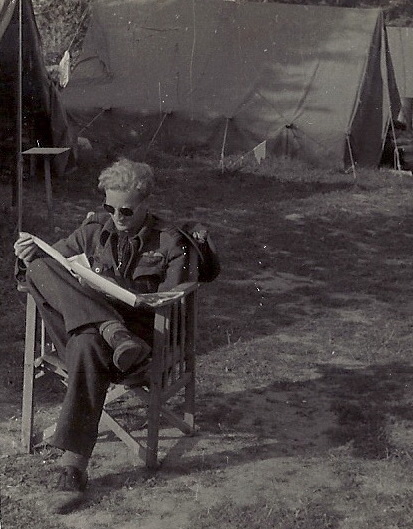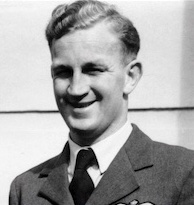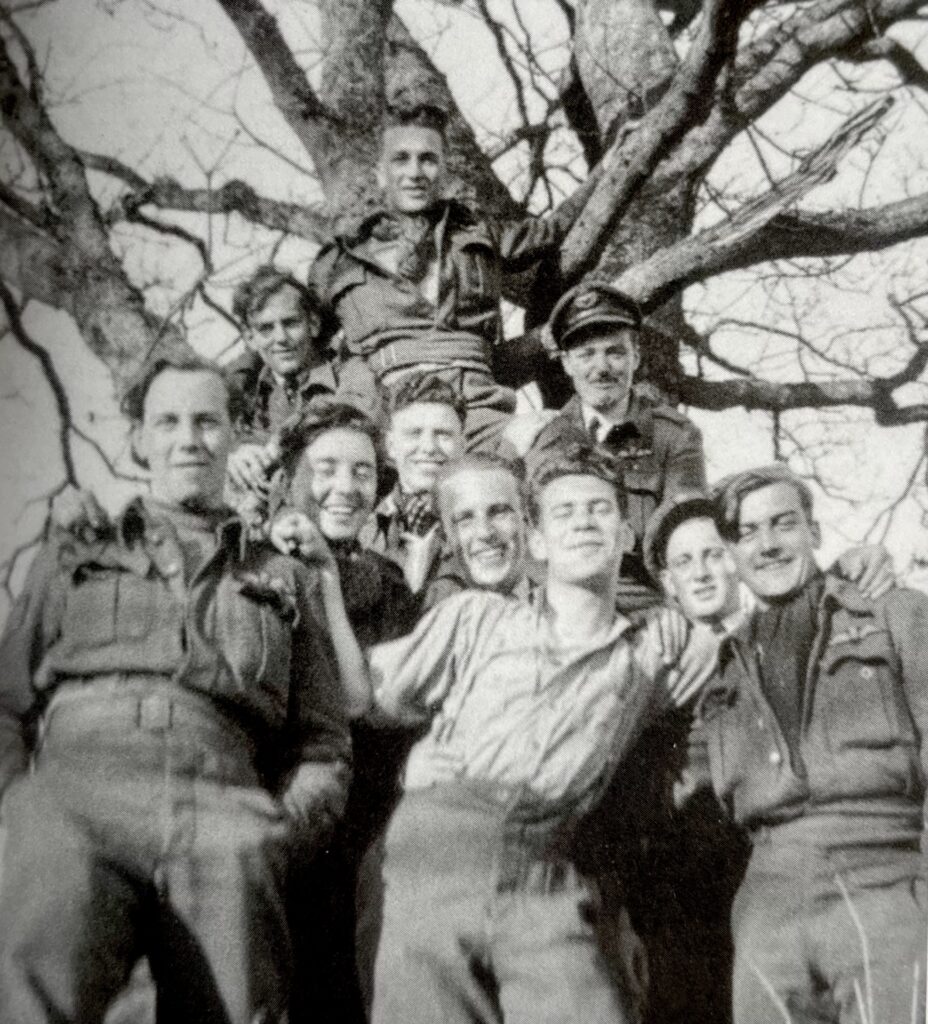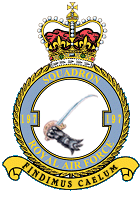
S/L Allan H. Smith, RNZAF
DFC & Bar
C. O. 197 Squadron, July 1944 – December 31st. 1944
(Shot down by flak over Holland, taken P.O.W., went on to live in Auckland, NZ)
197 Squadron flew under Denys Gillam as part of the Tangmere Wing and then stayed with him as part of 146 Wing through the lead-up to the Normandy invasion and then through France, Belgium, Holland and into Germany. he was then followed by Allan Henderson Smith.
My time with 197 Squadron
When I arrived at B-3 in France to take command of the Squadron they had a hard core of very experienced pilots. Some of the founding members of the Squadron – Ted Jolleys, Jimmy Kyle, Len Richardson, and Gubby Allen were reaching the end of their first tour. The bulk of the others had learnt operational flying under two very skilful Wing Leaders, Des Scott and Denys Gillam, as part of the Tangmere Typhoon Wing. They participated in the six-month buiId-up to the Normandy invasion where they attacked heavily defended targets in France on a daily basis, particularly radar stations, and gave active support to the D-Day landings. They were a highly professional group of ground attack pilots with whom it was a pleasure to fly.

I had previously only flown with New Zealand pilots and thought they were something special but my experience with 197 Squadron convinced me that high-calibre pilots are international. 197 Squadron comprised Canadians (Plamondon, Wakeman, Hall, Reid, Jones), Australians( James Welsh), English (Gilbert, Jolleys, Allan, Vance, Rook, Richardson, Lovell, Curwen, Harding, Rumbold, James, Mathews, Oury, Farmiloe, Bowman), Scotsmen (Kyle, Ellis, Irishmen (Byrne, Kilpatrick, Mahaffy), Welshmen (Price) and New Zealanders (Necklen).
When I became better acquainted with them and their flying ability it amazed me that so many of these high-class pilots were NCOs, so after a short conference with “Adj” Whitear I put ten of them up for commissions. Everybody told me I couldn’t do this and would have to dribble them through two or three at a time but my argument was that they had earned their commissions a long time ago and I was going to fight to the death to get them approved. I must have convinced somebody because they were all approved.
In the air, these pilots just went about their job without any fuss or bother. The targets allocated to us were studied carefully, and flak maps assessed; we worked out our method of attack and then went out and demolished the target. Afterwards, we would discuss the attack and fine-tune our tactics. Targets of any consequence were photographed by the PR Mustangs before and after the attack and confirmed the pilots’ reports of the success of the mission.

All the time I was there, 197 Squadron stayed a bomber squadron carrying out both dive-bombing and low-level attacks. Our preference was for the low-level approach using eleven-second delay bombs. On the missions we had a 100 per cent success rate because we worked out a technique that made it almost impossible to miss the target. Using stereo-pair photographs of the target we would work out an approach route that took us in below the height of the target building and would release our bombs at the last possible moment that would enable the aircraft to clear the building. Using this method the bombs had nowhere else to go but into the side of the building.
On free-ranging operations such as armed recces, the pilots would select their own targets and attack them with an enthusiasm and determination that earned them the respect of the Wing. Flak – sometimes very intense – was always a problem but I never saw it deter them from pressing home their attack.
They were also a very supportive group of pilots. Anyone in trouble was shielded and protected – if any of the section leaders were shot down somebody stepped in to take his place and the operation proceeded according to plan. New pilots on the Squadron (some with very few flying hours and no operational experience) were made welcome and nursed along on their early operations. If they survived the first week their chances improved dramatically.

We had our share of mavericks and wild ones and whilst some of these caused problems on the ground, in the air they all got on with the job. In fact, some of the “problem children” were the best people to have alongside you when the going got tough on a difficult target.
Once flying was over for the day, they all went their different ways. Some had a quiet drink and discussed the day’s flying – some wrote letters home. If we were near civilisation, others hit town and really lived it up. Whatever course they chose they had my support – each pilot had done a mighty job during the day and by the end of the week some of them would be dead.
My jeep was always available to them and featured in a few incidents. On one occasion they got the gears tangled up and reversed the jeep clean through the side of a house. Another time they were following the tram lines home and finished up in the tram depot at Antwerp. When they decided to move some of the trams whilst they were there, they cut the power off from a large part of the city. I didn’t mind what they did at night as long as they were ready and fit for flying the next morning.
Behind these pilots were two people who played a major part in their lives. The Adjutant, Victor Whitear, and the Doctor, Ken Horn. “Adj” Whitear was a very straight-laced conservative person and at first he was horrified by the way the boys conducted themselves when they let off steam and some of the language they used. As he got to know them better and saw the job they were doing day after day in the air he came to love them as though they were his own sons and mothered them like a clucky hen. He has since died but I saw him after the War and his affection for the pilots was undiminished. He told me that his time with 197 Squadron was the greatest experience of his life.
“Doc” Horn had been with 197 since its formation. I knew him from Tangmere days and was very pleased to see him still on the Squadron. The doctor on a frontline ground attack Squadron has a key role to play. The pilots are flying up to four missions a day – always in a hail of flak and on many occasions they see their best friends shot down. The enemies are fatigue and stress. Ken Horn was deeply involved in the Squadron and played his role to perfection. Quiet, unobtrusive, always available and ready to listen, he kept an eye on each pilot without them ever knowing they were under observation. The pilot who used to worry us most was the one who could not relax at the end of the day but stayed under tension worrying about the next day’s missions.
The way to beat stress was to live one day at a time, worry about things when they happened and then unwind at the end of the day.
Adj Whitear and “Doc” Horn were pure gold and the 197 pilots were very fortunate indeed to have two such concerned and competent people running interference for them.
Behind any squadron and making everything possible are the ground crew and 197 Squadron was no exception. Under “Chiefy” Adcock we were blessed with highly competent and dedicated personnel who busted their guts to keep the planes serviceable, often in atrocious conditions, and they refuelled and rearmed us in record times. They received very little public recognition for their role and on many occasions came under shellfire and attack from the air.
197 squadron had a very proud record of achievement and I feel very privileged to have flown with them.
Squadron, Leader Allan Smith RNZAF
January 12, 1921 – June 1, 2004
197 Squadron pilots had their first major reunion since the War in London in 1985 and got together again to present a 197 Squadron Crest to the RAF Club. Surviving squadron members continued Typhoon reunions, anniversaries and memorials well into their 90s. The last known surviving member of 197 Typhoon Squadron, Paddy Byrne, died on November 16, 2020.
